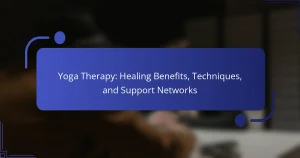Wellness retreats provide significant benefits such as stress reduction and improved mental health. They feature activities like yoga, meditation, and nutrition workshops, promoting relaxation and personal growth. Community engagement is essential, fostering connections among participants and enhancing the overall experience. Emerging trends for 2025 include personalized programs and sustainability practices, ensuring a fulfilling retreat.
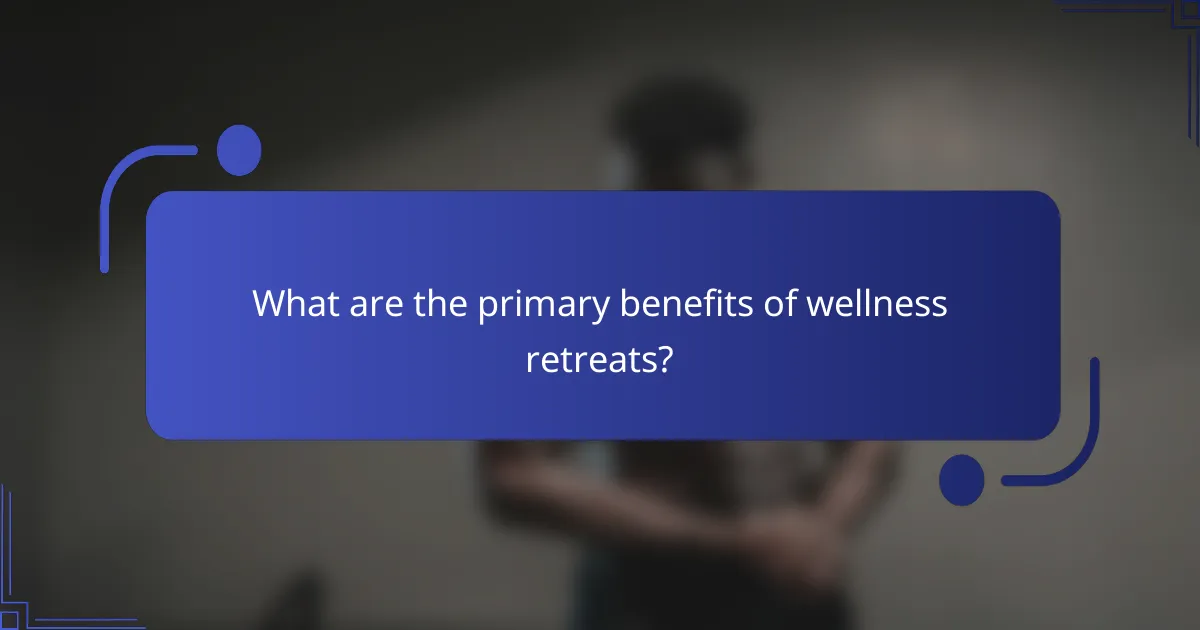
What are the primary benefits of wellness retreats?
Wellness retreats offer numerous benefits, including stress reduction, improved mental health, and enhanced physical well-being. Participants often experience transformative activities such as yoga, meditation, and nutrition workshops. These retreats foster a sense of community, allowing individuals to connect with like-minded peers, which enhances overall well-being. Additionally, the serene environments promote relaxation, further supporting emotional and physical rejuvenation.
How do wellness retreats improve mental health?
Wellness retreats significantly improve mental health by providing a supportive environment for relaxation and self-discovery. Participants engage in activities like yoga, meditation, and nature walks, which reduce stress and enhance emotional well-being.
The community aspect fosters connections, allowing individuals to share experiences and support each other. Research shows that social engagement during retreats can lead to lasting improvements in mood and resilience.
Moreover, these retreats often incorporate holistic practices, addressing both mental and physical health, which can lead to a comprehensive sense of well-being.
What physical health improvements can be achieved through wellness retreats?
Wellness retreats can lead to significant physical health improvements, including enhanced fitness, reduced stress, and better nutrition. Participants often engage in activities like yoga, hiking, and meditation, which promote cardiovascular health and flexibility.
Many retreats focus on healthy eating, teaching participants about nutrition and meal preparation, leading to long-term dietary changes. The community aspect fosters social connections, which can further enhance mental well-being and motivation for maintaining a healthy lifestyle.
Research indicates that regular participation in wellness retreats can lower blood pressure and improve overall physical health metrics. As a result, individuals often report feeling more energized and revitalized after their retreat experience.
How do wellness retreats foster emotional well-being?
Wellness retreats enhance emotional well-being through immersive experiences and community support. They provide a safe space for self-reflection and healing, promoting mindfulness practices like meditation and yoga. Participants often engage in group activities, fostering connections and reducing feelings of isolation. Research indicates that these environments can lower stress levels and improve mood, contributing to overall mental health.
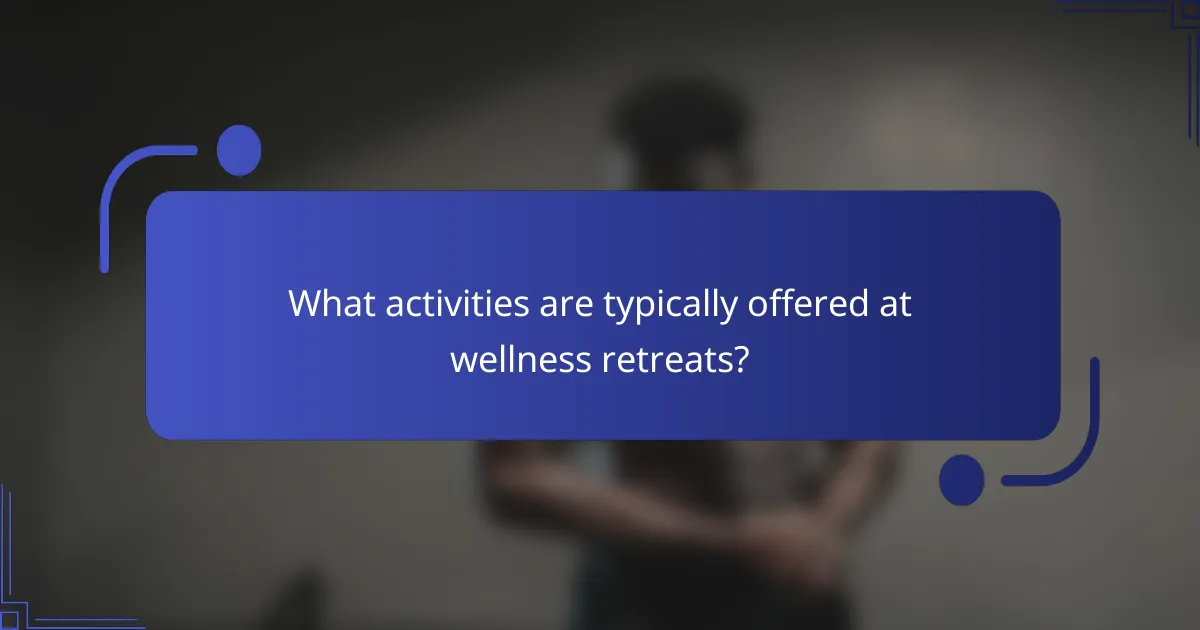
What activities are typically offered at wellness retreats?
Wellness retreats typically offer activities such as yoga, meditation, nutrition workshops, nature hikes, spa treatments, and group discussions. These activities promote relaxation, personal growth, and community engagement, enhancing overall well-being.
Which wellness practices are commonly featured in retreats?
Wellness retreats commonly feature practices such as yoga, meditation, mindfulness, nutritional workshops, nature walks, and community circles. These activities promote relaxation, personal growth, and social connection among participants. Engaging in these practices enhances overall well-being and fosters a sense of belonging.
How do dietary options enhance the retreat experience?
Dietary options significantly enhance the retreat experience by promoting physical health, mental clarity, and social connection. Healthy meals support detoxification, while mindful eating encourages participants to engage fully in activities.
Nutrient-rich diets can improve energy levels and mood, fostering a positive environment. Community meals create opportunities for bonding, enhancing the sense of belonging.
Additionally, specialized diets, such as plant-based or gluten-free, cater to diverse needs, ensuring inclusivity. This attention to dietary preferences reflects a commitment to holistic wellness, enriching the overall retreat experience.
What role does nature play in wellness retreat activities?
Nature plays a crucial role in wellness retreat activities by promoting relaxation and holistic healing. Natural settings reduce stress levels and enhance mental clarity. Activities such as hiking, yoga, and meditation often incorporate elements of nature, fostering a deeper connection to the environment. Research indicates that exposure to nature can improve mood and overall well-being, making it an essential aspect of wellness retreats.
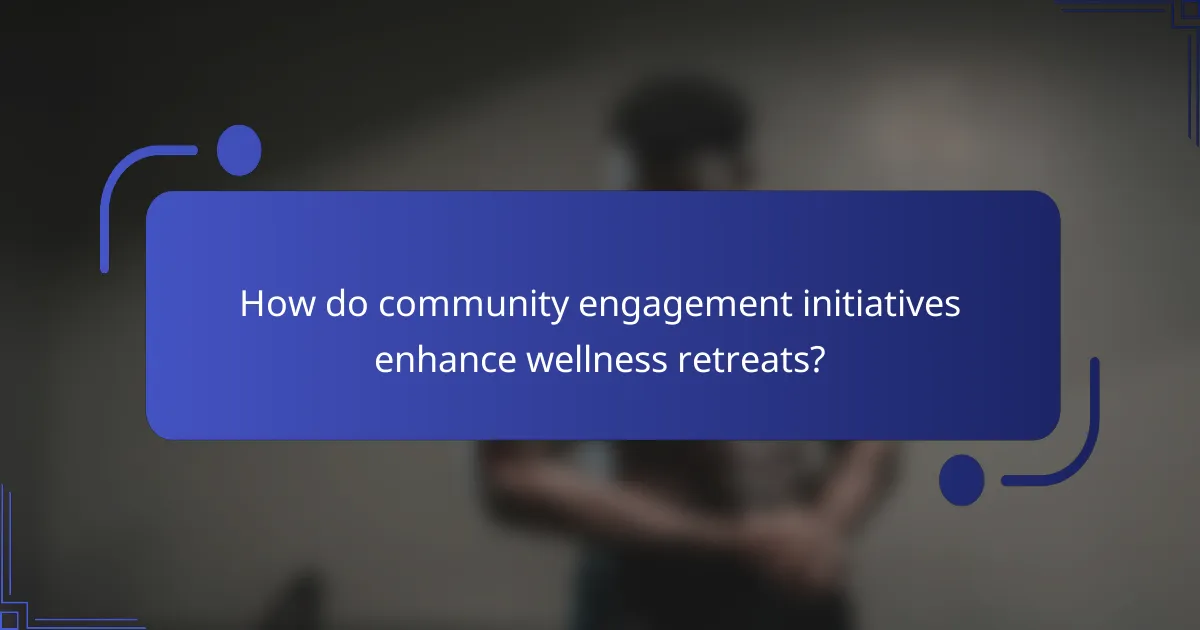
How do community engagement initiatives enhance wellness retreats?
Community engagement initiatives significantly enhance wellness retreats by fostering connection, support, and shared experiences. These initiatives create a sense of belonging, which is essential for mental and emotional well-being. Participants often engage in group activities that promote collaboration and communication, leading to stronger bonds and a supportive environment.
Additionally, community involvement can introduce diverse perspectives and practices, enriching the overall experience. For instance, local workshops or guest speakers can provide unique insights into wellness practices, making the retreat more comprehensive.
Moreover, wellness retreats that integrate community engagement often report higher participant satisfaction and retention rates. This is due to the personalized connections formed during the retreat, which encourage ongoing support and interaction beyond the event.
In summary, community engagement initiatives are vital for enhancing the overall effectiveness and enjoyment of wellness retreats, making them more impactful and memorable for participants.
In what ways can participants contribute to local communities during retreats?
Participants can contribute to local communities during retreats by engaging in service projects, sharing skills, and promoting local culture. These activities foster connections and support community development. For example, participants might organize clean-up drives, offer workshops, or support local artisans. Such contributions enhance the retreat experience while benefiting the surrounding area.
How do retreats promote social connections among attendees?
Wellness retreats foster social connections through shared experiences and group activities. Attendees engage in workshops, yoga sessions, and team-building exercises that cultivate a sense of belonging. These interactions create lasting friendships and networks, enhancing emotional well-being. Research indicates that social support is a key factor in overall health, making these connections vital for personal growth.
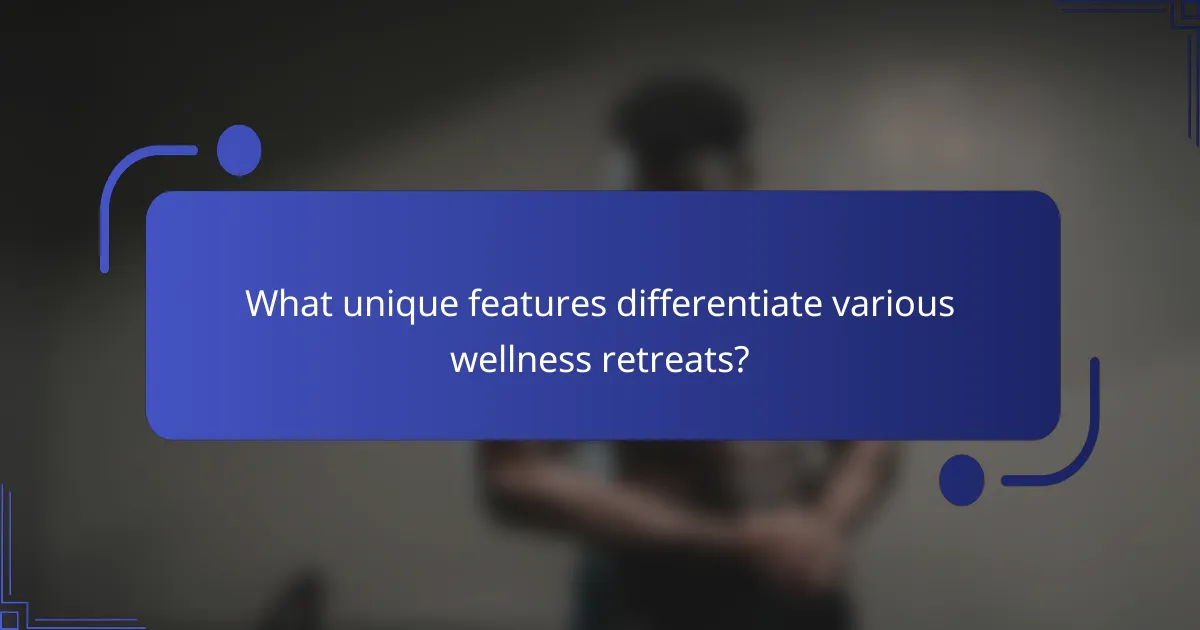
What unique features differentiate various wellness retreats?
Wellness retreats differ through unique features such as location, specialized programs, and community engagement. Locations range from serene mountains to tropical beaches, enhancing the experience. Specialized programs may focus on yoga, detox, or mindfulness, catering to specific wellness goals. Community engagement fosters connections among participants, creating a supportive environment that enhances personal growth.
How do cultural influences shape the wellness retreat experience?
Cultural influences significantly shape the wellness retreat experience by defining practices, rituals, and community interactions. Different cultures emphasize unique wellness philosophies, such as mindfulness in Buddhist traditions or holistic healing in Indigenous practices. These cultural elements enhance the retreat’s authenticity and effectiveness, creating a deeper connection among participants. Additionally, local cuisine, art, and music enrich the overall experience, fostering a sense of belonging and community engagement.
Which specialized programs cater to specific needs or demographics?
Wellness retreats offer specialized programs tailored to various needs, such as stress relief, detoxification, and personal development. Programs often focus on specific demographics like women, seniors, or corporate groups. For instance, women’s retreats may include workshops on empowerment, while corporate retreats often emphasize team-building activities. Each program typically features unique attributes, such as holistic therapies, fitness classes, and mindfulness practices, designed to enhance participant engagement and community connection.
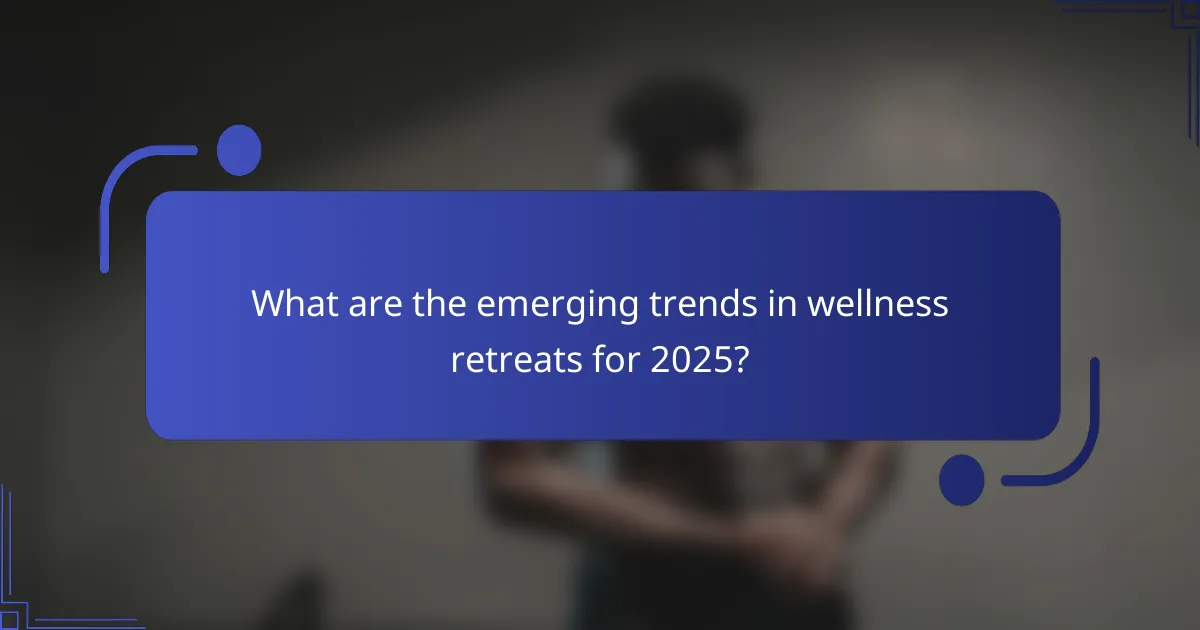
What are the emerging trends in wellness retreats for 2025?
Emerging trends in wellness retreats for 2025 include personalized wellness programs, technology integration, and sustainability practices. These retreats focus on individualized experiences, utilizing apps for tracking health metrics and enhancing engagement. Eco-friendly designs and local sourcing of food promote environmental responsibility. Community-building activities foster connections among participants, enhancing the overall retreat experience.
How is technology being integrated into wellness retreats?
Technology enhances wellness retreats by integrating digital tools for personalized experiences, virtual classes, and community engagement. Retreats utilize apps for tracking health metrics, scheduling activities, and connecting participants. Virtual reality meditation sessions create immersive environments, improving relaxation and focus. Wearable devices monitor vital signs, allowing tailored wellness programs that adapt to individual needs. This integration fosters a supportive community through online platforms where participants can share experiences and progress.
What sustainability practices are becoming popular in wellness retreats?
Sustainability practices gaining popularity in wellness retreats include organic farming, waste reduction, and renewable energy use. These practices enhance the retreat experience while promoting environmental responsibility.
Organic farming supports local ecosystems by using natural methods to grow food, ensuring fresh, healthy meals for guests. Waste reduction initiatives, such as composting and recycling, minimize environmental impact and promote a circular economy.
Renewable energy sources, like solar and wind, power facilities sustainably, reducing carbon footprints. Many retreats also engage in community outreach, collaborating with local organizations to support sustainable tourism and conservation efforts.
How are wellness retreats adapting to changing consumer preferences?
Wellness retreats are increasingly incorporating personalized experiences and sustainable practices to meet evolving consumer preferences. Many now offer tailored wellness programs that address individual health goals.
Additionally, the integration of technology enhances engagement. Virtual wellness components allow remote participation, catering to wider audiences.
Community engagement has become essential, with retreats emphasizing local culture and supporting nearby businesses. This approach fosters a sense of connection and authenticity.
The focus on mental health and holistic well-being is rising, with activities like mindfulness and meditation being prioritized. As a result, wellness retreats are transforming to align with contemporary consumer values.

What common mistakes should be avoided when choosing a wellness retreat?
When choosing a wellness retreat, avoid common mistakes to ensure a fulfilling experience. First, don’t overlook your personal goals; choose a retreat that aligns with your wellness objectives. Second, consider the location and environment; your surroundings significantly impact relaxation and engagement. Third, research the retreat’s reputation; read reviews and testimonials to gauge the quality of services offered. Finally, clarify the costs involved; hidden fees can affect your budget and overall satisfaction.
How can participants assess the credibility of wellness retreat providers?
Participants can assess the credibility of wellness retreat providers by researching their qualifications, reviews, and affiliations. Look for certifications from recognized organizations, testimonials from past attendees, and partnerships with reputable wellness brands. Verify the retreat’s transparency regarding its practices, pricing, and policies. Additionally, consider the retreat’s location and the expertise of its facilitators, as these can indicate the quality of the experience offered.
What should be considered when evaluating retreat locations?
When evaluating wellness retreat locations, consider accessibility, amenities, environment, and community engagement. Accessibility ensures participants can reach the location easily, while amenities contribute to comfort and enjoyment. The environment should promote relaxation and wellness, enhancing the overall experience. Community engagement fosters connections and support among participants, enriching the retreat experience.
How can one ensure they choose the right activities for their wellness goals?
To choose the right activities for wellness goals, assess personal objectives and interests first. Align activities with desired outcomes, such as stress reduction or physical fitness. Consider the community aspect of wellness retreats, as engaging with like-minded individuals enhances motivation and accountability. Evaluate the variety of activities offered, ensuring they cater to different preferences and fitness levels.
What are the best practices for maximizing the benefits of a wellness retreat?
To maximize the benefits of a wellness retreat, prioritize planning, engagement, and reflection. Choose a retreat that aligns with personal goals and wellness themes. Participate actively in activities, such as yoga or meditation, to enhance physical and mental well-being. Foster connections with fellow attendees to build a supportive community. Lastly, take time for personal reflection to integrate experiences into daily life.
